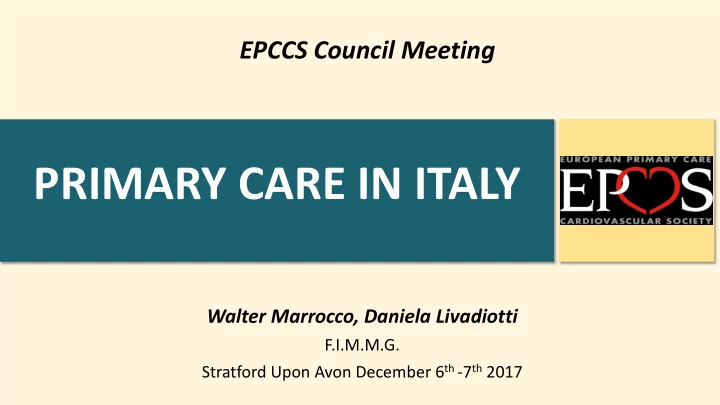

EPCCS Council Meeting PRIMARY CARE IN ITALY Walter Marrocco, Daniela Livadiotti F.I.M.M.G. Stratford Upon Avon December 6 th -7 th 2017
Population size and main characteristics in Italy December 31, 2016 60,589,445 inhabitants, more than 5 million of whom had foreign citizenship: 8.3% at national level. Foreigners 8,3% Trend of the population with foreign citizenship 2017 ITALY - source: ISTAT January 1, 2017 - Processing TUTTITALIA.IT (*) post-census
Population size and main characteristics in Italy Thousand The decrease in the number of births that started in 2008 is still going on. In 2016 children born were less than half a million, just over 69,000 TOTAL of which were foreign (14.7% of from both italian parents the total). from at least one foreign parent from both foreign parents Compared to 2015, there was an overall reduction of 12,000 units (2,700 for the foreigners).
Population size and main characteristics in Italy Italy has one of the highest ELDER ERLY LY POPU PULAT LATION rates of population ageing in January 1, 2007 and 2017 Europe and at global level. 21.4 % of the population is 65 11,7 million 13,5 million years and older. 20,1% of the population 22,3% of the population ≥ 65 YEARS In this age group, 3 % are older 727.000 466.700 ≥ 90 YEARS elderly people, i.e. aged 85 0,8% of the population 1,2% of the population years or more, and of these 10.386 17.000 16,390 are over hundred-year- 0,02% of the population CENTENARIANS 0,03% of the population old.
Population size and main characteristics in Italy Over 8 million people – i.e. almost 15% of the total population - suffer from at least one serious chronic illness. This prevalence is strongly increasing with age and reaches 50% in those aged over 80 years.
CRONIC DESEASES Muscol-scheletric Illness Ipertension Reumatic Illness Diabetes KCD Dislipidemia Gastrointestinal diseases CV diseases Distiroidism Cerebrovascolar diseases Neoplasms Psychiatric diseases Deafness Neurological diseases Blindness Respiratory diseases Genetic diseases
GPs in Italy: Numbers, practice types, organization, training About 47,000 general practitioners (GPs) and 13,000 non-stop assistance physicians GPs are freelancers under contract with the NHS and therefore are self-employed and not in the employ of the NHS.
GPs in Italy: Numbers, practice types, organization, training Every citizen has the right to freely choose his own GP and can change his choice at any time. Each GP has a list of patients. The maximum number of patients for each GP (the so-called ceiling) is 1,500 people. In Italy every GP has on average 1100 adult patients (aged over 14 years).
GPs in Italy: Numbers, practice types, organization, training To access General Medicine, a specific training certificate in general medicine is required. Specific Training: ✓ a three-year practical and theoretical course carried out at regional level. ✓ a general-practice certificate is issued for the exercise of general medicine under the NHS.
GP’s practice GP’s Surgeries GP’s surgeries are open at least 5 days a week (but in many cases even on Saturday morning for at least 2 hours), and ensure availability throughout the day from 8am to 8pm. Non-Stop Assistance From 8pm to 8am, non-stop assistance physicians operate, guaranteeing home and outpatient care in assisted structures during night times, pre-holidays and public holidays. A non-stop assistance physician is foreseen every 5,000 inhabitants.
GP’s practice In recent decades, GP's activity has been evolving from “solo” work to teamwork, through participation in associative forms of general medicine and the use of surgery’s staff. A reorganization of the primary care system has been introduced. The Regions should define the organization of local services through the establishment of single-specialization teams, consisting of just GPs, and multi- specialization teams, which shall provide medical care through the coordination and integration of GPs, other professionals in the area (paediatricians), nurses, midwifery, medical technical staff, rehabilitation staff, prevention and social staff. Teamwork and professional integration should provide a more complete and qualified response to the needs of the population, operating on a 24 h/7d basis.
www.fimmg.org
Walter Marrocco wmarrocco54@gmail.com Daniela Livadiotti danielalivadiotti@libero.it
Recommend
More recommend